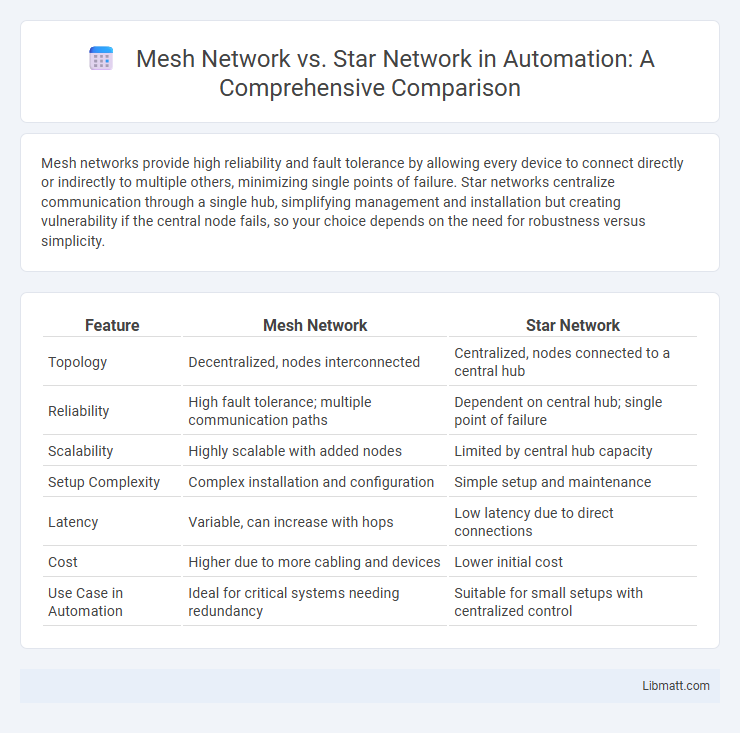Mesh networks provide high reliability and fault tolerance by allowing every device to connect directly or indirectly to multiple others, minimizing single points of failure. Star networks centralize communication through a single hub, simplifying management and installation but creating vulnerability if the central node fails, so your choice depends on the need for robustness versus simplicity.
Table of Comparison
| Feature | Mesh Network | Star Network |
|---|---|---|
| Topology | Decentralized, nodes interconnected | Centralized, nodes connected to a central hub |
| Reliability | High fault tolerance; multiple communication paths | Dependent on central hub; single point of failure |
| Scalability | Highly scalable with added nodes | Limited by central hub capacity |
| Setup Complexity | Complex installation and configuration | Simple setup and maintenance |
| Latency | Variable, can increase with hops | Low latency due to direct connections |
| Cost | Higher due to more cabling and devices | Lower initial cost |
| Use Case in Automation | Ideal for critical systems needing redundancy | Suitable for small setups with centralized control |
Introduction to Network Topologies
Mesh networks feature interconnected nodes where each device relays data for the network, enhancing reliability and redundancy through multiple pathways. Star networks consist of a central hub connecting all peripheral devices, simplifying network management but creating a single point of failure. This contrast in structure impacts scalability, fault tolerance, and maintenance in network topology design.
What is a Mesh Network?
A Mesh Network is a decentralized network topology where each device, or node, connects directly to multiple other nodes, creating a web-like structure for efficient data routing. This configuration enhances reliability and coverage by allowing data to travel through multiple paths, reducing the risk of a single point of failure. In contrast to a Star Network, where all devices connect to a central hub, a Mesh Network dynamically adapts to node availability, improving your network's resilience and scalability.
What is a Star Network?
A Star Network is a network topology where each device is connected to a central hub or switch, enabling direct communication between the hub and individual nodes. It offers straightforward installation, easy fault isolation, and centralized management, making it ideal for small to medium-sized networks. However, the central hub represents a single point of failure, affecting the entire network if it malfunctions.
Key Differences Between Mesh and Star Networks
Mesh networks feature multiple interconnected nodes that create redundant communication paths, enhancing reliability and fault tolerance. Star networks rely on a central hub to manage data transmission between devices, simplifying management but creating a single point of failure. Your choice between mesh and star topologies depends on factors like network size, scalability, and the desired balance of reliability versus ease of maintenance.
Advantages of Mesh Networks
Mesh networks offer superior reliability and fault tolerance by allowing devices to connect directly with multiple nodes, ensuring continuous communication even if one node fails. These networks excel in coverage and scalability, making them ideal for large or complex environments where consistent connectivity is crucial. Your network benefits from enhanced redundancy and self-healing capabilities, reducing downtime and maintenance costs.
Advantages of Star Networks
Star networks offer centralized management with a single hub that simplifies troubleshooting and network control. This topology provides higher performance as each device connects directly to the hub, reducing data packet collisions. Your network benefits from easy scalability and enhanced security since the hub can monitor and restrict data flow effectively.
Disadvantages of Mesh Networks
Mesh networks suffer from complex installation and maintenance due to the numerous interconnections between nodes, increasing costs and setup time. The extensive wiring or wireless links can cause scalability issues as the network grows, impacting performance and reliability. Your network might also face higher power consumption and potential signal interference compared to simpler topologies like star networks.
Disadvantages of Star Networks
Star networks face significant drawbacks such as a single point of failure at the central hub, which can disrupt the entire network if the hub malfunctions. Scalability is limited because adding more devices can overload the central hub, leading to reduced performance and increased latency. Your network's reliability may also suffer in star configurations due to dependency on the central node for all data transmissions.
Use Cases: When to Choose Mesh or Star Topology
Mesh networks excel in environments requiring high reliability and redundancy, such as industrial automation, smart homes, and emergency communication systems, where continuous connectivity is critical. Star networks suit scenarios with centralized management and straightforward device connections like office LANs, home Wi-Fi setups, or small business networks, offering ease of maintenance and scalability. Your choice depends on whether you prioritize network resiliency and fault tolerance (mesh) or simplicity and centralized control (star).
Conclusion: Which Network Topology is Right for You?
Mesh networks offer superior redundancy and reliable performance by connecting each node directly to multiple others, making them ideal for environments requiring high fault tolerance and continuous connectivity. Star networks simplify management and troubleshooting by centralizing connections through a single hub, best suited for small to medium-sized setups where ease of installation and cost efficiency are priorities. Choosing the right topology depends on balancing network size, reliability needs, budget constraints, and scalability requirements for your specific application.
Mesh Network vs Star Network Infographic

 libmatt.com
libmatt.com